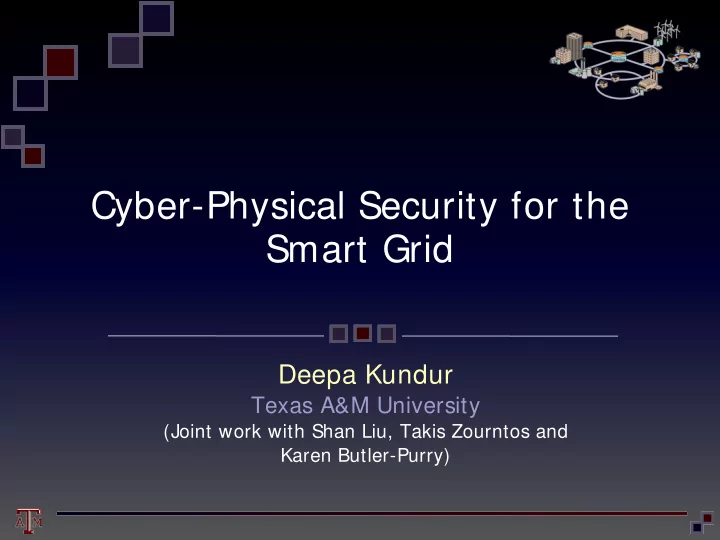

Cyber-Physical Security for the Smart Grid Deepa Kundur Texas A&M University (Joint work with Shan Liu, Takis Zourntos and Karen Butler-Purry)
CYBER SECURITY POWER SYSTEMS DYNAMICAL SYSTEMS 2
A Smarter Grid MARRIAGE OF INFORMATION TECHNOLOGY WITH THE EXISTING ELECTRICITY NETWORK Bidirectional information transfer! Bidirectional energy transfer! 3
Why Cyber Protect the Grid? INCREASED MOTIVATION INCREASED OPPORTUNITY Technical Public-Welfare Business TERRORISM SECURE FOR COMPLIANCE PHYSICAL DAMAGE PROTECT/REDUCE LIABILITY CASCADING FAILURES ASSURE REVENUE 4
What has history taught us? Commerce IMPERSONATION eCommerce has provided greater consumer- and vendor-centricity Entertainment PIRACY Digital entertainment has enabled more flexible business models Friendship PRIVACY Social networking has allowed us to keep in touch with geographically distant friends 5
Lessons Learned Cyber security should be part of system design. Cyber security is a support service that should not hinder usability Cyber security is a process; no system is completely secure. 6
Cyber-Physical Interface 7
Cyber-Physical Interface 8
Fundamental R&D Questions What are the electrical system impacts of a cyber attack? How should security resources be prioritized for the greatest advantage? Is the new data/control worth the security risk? 9
Of Interest to the EPU Community Attacks on information accuracy False data injection attacks Attacks on timely delivery Denial of information access Attacks on access control Reconfiguration attacks 10
Design Mantra “ Cyber assets are targets of cyber attacks. ” Cyber assets: Any data, device or component of the environment that supports information- related activities E.g., IEDs, PLCs, RTUs, PMUs, PDCs, SCADA, AMI, communication infrastructure … 11
False Data Injection Attacks Liu et al. (2009) Corruption of measurements: z a = z + a, for a = Hc and constraints on a Figures of merit: Likelihood of finding a Impact = ||x a – x|| STATE ESTIMATION 12
Denial-of-Service Attacks How do you make decisions with lack of or delayed information? H(s) G(s) 13
Risk Risk = Likelihood x Impact Risk = P Threats x P Vulnerabilities x Impact THREATS COMMUNICATIONS GENERATION ACTUATORS NATURALLY OCCURRING INTERNET XMISSION SENSORS UNTRAINED PERSONNEL GRID COMPLEXITY XMISSION ACTUATORS MALICIOUS INSIDERS CONTROL SYSTEM DISTRIB SENSORS ICT Power System COMPLEXITY LONE ACTORS DISTRIB ACTUATORS Simulator Simulator NEW SYSTEMS ORGANIZED CRIME DISTRIB GNERATION NEW DEVICES TERRORISM MICROGRIDS NATION-STATES IMPACT AREAS GENERATION SENSORS VLUNERABILITIES 14
Emerging Design Mantra “ Cyber-physical assets are targets of cyber-physical attacks .” Cyber-physical assets: Any component of the environment that supports energy-related activities E.g., IEDs, PLCs, RTUs, PMUs, PDCs, SCADA, AMI, communication infrastructure, energy sources, transformers, transmission lines, buses, loads 15
Cyber-Physical Vulnerabilities Cyber assets can be direct targets of cyber and physical attacks. Physical assets can be direct targets of physical attack and indirect targets of cyber attack. 16
Cyber-Physical Attacks Evolving definitions: A coordinated set of cyber and physical attacks on cyber-physical assets with the goal of maximizing physical disruption E.g., combination of transmission line fault with state estimation modification A cyber attack employed on a cyber asset with the goal of disruptive impacts to the physical assets E.g., control signal modification to reconfigure power system to an emergency state Emerging Grand challenge: Modeling 17
Modeling Wish List Tight coupling of cyber and physical components: time-scale integration, vulnerability analysis Formalism using powerful mathematical constructs Flexible granularity of modeling detail to tune complexity ‘What if’ analysis possible. 18
✓ Formalism Variable granularity ‘What if’ analysis Dynamical Systems How can you model cyber and physical entities within a common framework? Dynamical Systems Describes time evolution of state vector: Models physics of power systems effectively 19
20
13 Node System 21
Graph Model 22
Of Interest to the Power Community Attacks on information accuracy False data injection attacks Attacks on timely delivery Denial of information access Attacks on access control Reconfiguration attacks 23
Cyber-Physical Attacks Evolving definitions: A coordinated set of cyber and physical attacks on cyber-physical assets with the goal of maximizing physical disruption E.g., combination of transmission line fault with state estimation modification A cyber attack employed on a cyber asset with the goal of disruptive impacts to the physical assets E.g., control signal modification to reconfigure power system to an emergency state 24
Coordinated Switching Attacks Smart grid envisions remote access of circuit breakers and switches Breaker control signals are corrupted Exploits physical vulnerabilities from reconfiguration 25
Coordinated Switching Attacks Goal: physical disruption through rotor angle instability Exploit local state info to define a disruptive cyber control switching sequence Model the cyber-physical system as a type of hybrid dynamic system: Exhibit both continuous and discrete behaviors 26
Variable Structure System switching signal 27
Variable Structure System 28
Variable Structure System 29
Static Switch Phase Portraits 30
Variable Structure System 31
Variable Structure System 32
The Sliding Mode “Emergent” property from switching that has characteristics different from individual subsystems Motion of state trajectory along a chosen line/plane/surface 33
Existence of Sliding Mode s>0 s<0 34
Attack Construction 1. Represent smart system as variable structure system whereby s(x) is general. 2. Determine existence of and identify class of sliding modes. 3. Assign identified sliding surface for attack. 35
Western Electricity Coordinating Council, 3 WECC System machine, 9-bus system 36
Step 1: Modeling 37
Step 2: Existence of Sliding Mode Phase Portrait of A 1 Phase Portrait of A 2 Overlapping Close-up 38
Step 2: Existence of Sliding Mode A 1 A 2 VALID SLIDING SURFACE 39
Step 3: Assign s(x) for attack 40
Attack Simulation on SMIB Model Switching applied From 0 s to 2.5 s. 41
Attack Simulation on WECC PSCAD Simulations 42
Attack Simulation on WECC 43
Final Remarks Coordinated variable structure switching attacks represent a new class of attacks aimed specifically to disrupt power system operation. Hybrid dynamical system models are effective tools in vulnerability analysis. 44
Where should we go from here? Develop common problem formulations within community Exciting area, but still ad hoc Encourage greater collaboration amongst power system researchers, control theorists and information technology community 45
Contact Dr. Deepa Kundur Associate Professor Electrical & Computer Engineering Texas A&M University dkundur@tamu.edu http://www.ece.tamu.edu/~ deepa/ 46
Recommend
More recommend